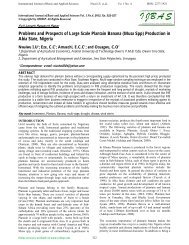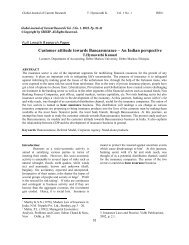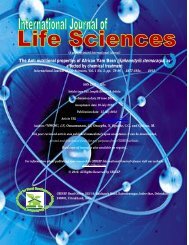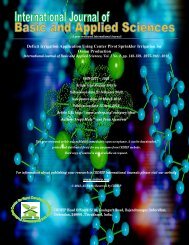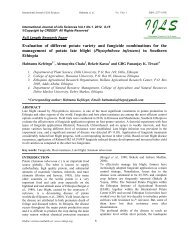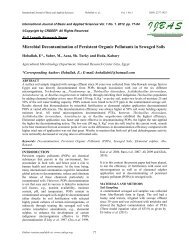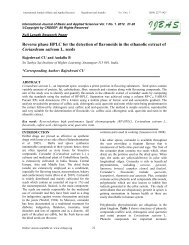Download Pdf - CRDEEP
Download Pdf - CRDEEP
Download Pdf - CRDEEP
You also want an ePaper? Increase the reach of your titles
YUMPU automatically turns print PDFs into web optimized ePapers that Google loves.
International Journal of Basic and Applied Sciences Ikhayere et. .al, Vol. 1 No. 3 ISSN: 2277-1921<br />
International Journal of Basic and Applied Sciences Vol.1 No.3. 2012. Pp. 263- 266<br />
©Copyright by <strong>CRDEEP</strong>. All Rights Reserved<br />
Full Length Research Paper<br />
Synthesis and Characterization of Polyesteramide Resin from Rubber Seed Oil for<br />
Surface Coating Application<br />
Ikhayere Stephen 1 *, S.O. Ohikhena 2 , Ekebafe 1 L.O.,<br />
1<br />
Department of Polymer Technology, Auchi Polytechnic, Auchi, Edo State Nigeria<br />
Department of Chemical Engineering Technology, Auchi Polytechnic, P.M.B. 13, Auchi, Nigeria<br />
*Corresponding Author: khasteve019@yahoo.com<br />
Abstract<br />
The polyesteramide resin was synthesized from adipic acid, N,N-bis-(2-hydroxyethyl) and Hevea brasiliensis. Fatty amide was obtained<br />
from methyl ester of the rubber seed oil by treatment with diethanol amine. The synthesized intermediates and resin were characterized<br />
in terms of acid value, iodine value, saponification value, drying time and specific gravity. The coating performance of the resins was<br />
tested by measurement of pencil hardness, adhesion and chemical resistance. The polyesteramide resin has lower saponification value<br />
than the oil. The lower iodine value of the polyesteramide resin is obviously due to the reduction of the molecular mass of the oil which<br />
accommodates the unsaturation present in the fatty acids of the oil. The resin has a short set to touch time but a considerably long dry<br />
through time of 5 hours, the oil is probably a semi drying oil rather than a none drying or drying oil.<br />
Keywords: Rubber seed oil, Polyesteramide resin, Surface coating, triglycerides, curing<br />
Introduction<br />
Polyesteramide resins are products of poly-condensation<br />
reaction between polybasic acid polyhydric alcohols modified<br />
with fatty acid or drying oil. Oil modified polyhydric<br />
polyesteramide resin constitute a major group of resin used as<br />
blinders in surface coatings. It is estimated that polyester<br />
amide resins contribute about 70% to the conventional binders<br />
used in surface coating today .(1) The popularity of<br />
polyesteramide as vehicle for coatings is largely due to their<br />
unique properties such as film hardness, durability, gloss and<br />
gloss retention, resistance to abrasion etc. impacted on them<br />
through modification with drying oils. (2) The oils that are<br />
mostly employed for polyesteramide resins synthesis are<br />
linseed, soybean, castor, tall oils. (3) These oils are largely<br />
imported to Nigeria for the formulation of coatings for metal<br />
cans used in packing of beverages, drugs, food etc. however,<br />
drying oils are available locally, which have remained<br />
untapped. These include rubber seed oil, soybean oil, walnut<br />
oil and tobacco oil. (4) Rubber seed is obtained in high yield as<br />
a by-product of (Heavea-Brasiliensis) rubber tree cultivated<br />
primarily for its latex. (5) Further, it was also found that the<br />
kernels comprises 50% of the whole seed and yield 42.39%<br />
oil, these reports have eventually generated a lot of interest in<br />
the rubber seed across the world. (6) However, research has<br />
shown it be a rich source of oil that is comparable in quality to<br />
try oils commonly used in surfacing (7) .<br />
Online version available at: www.crdeep.com<br />
263<br />
Materials and Methods<br />
Materials<br />
Rubber Seed Oil was obtained from the Rubber Research<br />
Institute of Nigeria, Benin City, Xylene, Adipic Acid , Lead<br />
Mono-Oxide, Methyl-ethyl ketone Peroxide, Metallic<br />
Sodium, and Methanol , Anhydrous Sodium Sulfate, Ethanol,<br />
Potassium Hydroxide Sodium Thiosoulphate were supplied<br />
and are products of BDH, England. Styrene, and Diethanol<br />
Amine are products of Sigma-Aldrich, Germany<br />
Preparation of methylester of the oil<br />
Twenty five grams of oil in 50ml super dry methanol and<br />
0.5% sodium methoxide (with respect to the oil) were refluxed<br />
for 3hrs in 250ml round bottom flask in air. The content of<br />
flask were then cooled to room temperature and kept<br />
overnight. The excess methanol was removed by distillation<br />
and the methyl esters were extracted by petroleum ester (b.p.<br />
60-80 o c), washed with 15% aqueous NaCl solution and dried<br />
over anhydrous sodium sulfate. The methyl esters of the<br />
mixed fatty acids were purified from ester by distillation.<br />
Quantitative yield of the product was obtained.<br />
Preparation of diethanol amide from the methylester of the<br />
oil<br />
A three-necked round bottom flask equipped with a<br />
mechanical stirrer,and a dropping funnel were used for the<br />
preparation for the diethanol amide of the esters. 3.45g<br />
diethanol amine and 0.5% sodium methoxide (with respect to<br />
the ester) were taken in the flask with constant stirring under<br />
the presence of air and heated to 110-115 o C, then the methyl



